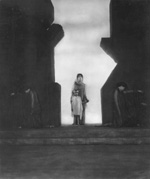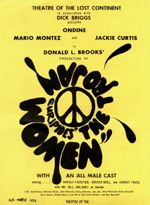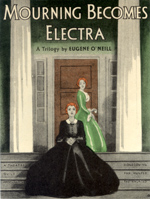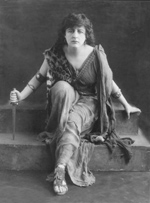The New York Public Library for the Performing Arts
Inspired by
Hellenic narratives
 Edith Wynne Mathison as
Edith Wynne Mathison as
Andromache, 1917. – Billy
Rose Theatre Collection, NYPL
 Federal Theatre Project's The
Federal Theatre Project's The
Trojan Incident,
1938. – Billy
Rose Theatre Collection,
NYPL
 Theatre of the Lost Continent's
Theatre of the Lost Continent's
The Trojan Women, 1974.
– Billy Rose Theatre Collection,
NYPL
 Eugene O'Neill's Mourning
Eugene O'Neill's Mourning
Becomes Electra. –
Billy Rose
Theatre Collection, NYPL
The stories of gods and heroes formed the subject matter of the extant Greek
tragedies of Aeschylus, Sophocles and Euripides, which had been written for
annual Dionysian festivals in Athens. Translations of those plays, of Homer’s
epics, The Iliad and The Odyssey, and of other narratives were available
in English. Gilbert Murray’s translations of the plays were the most
popular for performance, but other adaptations were also used. Revivals and
reinterpretations of the Greek tragedies, epics and tales gave theater, dance
and music creators throughout the century a chance to create new forms of
performance and production.
The exhibit divides these works by subject matter, not performing arts genre.
Tales of Troy – The Iliad, The Odessey and the House of Atreus.
Topical issues were often attached to tales of the Trojan War and its protagonists.
Plays of the House of Atreus, such as Electra, deal with issues of fate and
justice. The Trojan Women, called “one of the greatest pacifist documents
in the world,” emerges to represent refugees and victims of war.
Tales of Dionysius and the Bacchantes were presented in eras of social change.
Tales of heroes, such as Jason, Theseus and Oedipus were re-interpreted to
focus on the women characters, as in choreographer Martha Graham’s
works about Ariadne, Jocasta, Alcestis, and Circe, among others. Medea, a
study in anger, has been a catalyst for new interpretations and experimental
performance throughout the century.
 Margaret Anglin as Medea, ca. 1917.
Margaret Anglin as Medea, ca. 1917.
– Billy RoseTheatre Collection, NYPL

Sketches by Judith Malina
of the
Living Theatre's Antigone, 1967.
Living Theatre
Records, – Billy Rose
Theatre Collection, NYPL